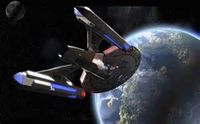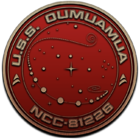Eesse
| “Huli ke alo i ka paia” -- “Turn the face to the wall (for there is nothing to fear)" | ||||
| - Hawaiian Proverb |
| USS Oumuamua | ||
|---|---|---|
 ACTIVE STATUS | ||
| ||
- NOTE: This species was created for a mission and is not currently playable.
The Eesse are a sentient flora species that resembled Terran trees.
History
Eesse history is stored in what is known as the 'Great Memory', an organic computer into which their knowledge and past has been poured. In general, it is an insular existence on a planet that has since their departure been rendered uninhabitable. Other life forms existed on their home planet, but the Eesse kept to themselves. Then, a catastrophic event known as the 'Great Disaster' poisoned their planet. With their numbers dwindling, the Eesse constructed an organic ship with solar sails to power it and left the planet to find the 'Promised Place', another planet that was considered a holy site reserved for their salvation. In 2399, The USS Oumuamua discovered their damaged ship and made contact where they discovered the Eesse were dying from an unknown disease.
Government
The Eesse were led by a couple who inherited the title of Grand Matriarch and Grand Patriarch. These two governed together and had equal status. Generally, they were the oldest and wisest of their people.
Description
Although they resembled trees such as can be found on Earth, Bajor, Betazed and other M-Class planets, the Eesse are sentient. Able to move at will, they are characterised by silver bark and gold leaves, but varied widely in other characteristics, such as smoothness of bark, shape of the leaves, types of limbs, etc. Their height and girth had a direct correlation to their age - the older they are, the larger they are.
Physiology
As typical with vascular plants, tubes contained in the inner structure of their physiology transport water and nutrients all throughout their bodies. Eesse can be male, female, or monoecious and thus be considered both. Depending upon the situation and environment, they have the ability to also change gender. Eesse can have extremely long lives, at least several hundred years in length.

